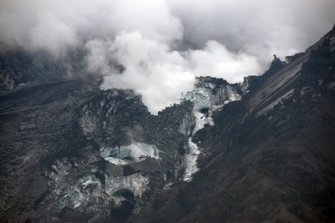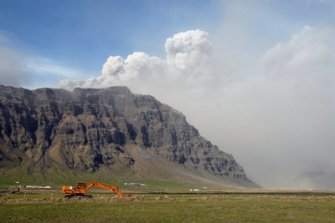Eyjafjallajökull Update for 5/7/2010

nThe Gígjökull outlet glacier on Eyjafjallajökull, showing the steaming lava flow carving its way through the glacier. Image taken May 5, 2010 by Dr. Joseph Licciardi.
nn
A quick update on the ongoing activity at Eyjafjallajökull:
nn
The activity at the volcano continues to be more explosive during the last few days than it was in the previous week, leading to more potential for airspace closures over Europe if the winds were to shift. Currently, the VAAC ash advisory only seems to suggest that even Spain may get a taste of the ash sometime tomorrow, but most of Europe will be OK. However, transatlantic routes to Europe could have problems as many flights will need to be routed significantly south to get around the ash. All of this has now lead for a push for satellites that can detect ash more effectively. Tourism in Iceland has seen a boom since the eruption started – one of the economic plusses in a story that has emphasized the minuses.
nn
The latest Icelandic Met Office update for the volcano has the plume reaching 9km / 30,000 feet, which is one of the highest levels we’ve seen for this plume so far. Ash fall has become severe in some parts of Iceland, where even 65-70 km away from the vent “everything has turned black.”I haven’t been able to find much else about the “bulging” reported yesterday in the USA Today other than the IMO mentioning “Increased seismicity suggests that new material is intruding from deep below Eyjafjallajökull and latest GPS-observations suggest inflation. So far, GPS-signals are not large.” My guess is that the inflation isn’t significant, just noticeable on the installed GPS receivers. The composition of the lavas erupting from Eyjafjallajökull are squarely andesitic (well, at least the one sample analyzed so far) – and it does suggest that the current phase of the eruption is more silicic than the original fissure and the eruptions on the volcano in late April. This might suggest that the basaltic magma from depth is still effectively mixing with the more silicic (rhyolite) mush in the Eyjafjallajökull magmatic system.
nn
I discovered the other day that a friend of mine from graduate school is in Iceland right now watching the eruption. Dr. Joe Licciardi is a professor at University of New Hampshire who studies subglacial volcanism (from the glacial side) so he headed out to check the processes in action. The two images in this post are from Joe (thanks!) showing the state of the Gígjökull glacier (in much worse shape than it was a week ago; above) and a shot of the air quality in southern Iceland (with the plume in the background; below). Lets just say I’m more than a little jealous of Joe right now …
nn

nVolcanic haze (foreground) and the Eyjafjallajökull plume (background). Taken May 5, 2010 by Dr. Joseph Licciardi.
nn
UPDATE 7:15 PM 5/7/2010: The NASA EO posted n”_blank”>a nice image of the recent plume, showing both the main plume and the windblown lower altitude ash.




